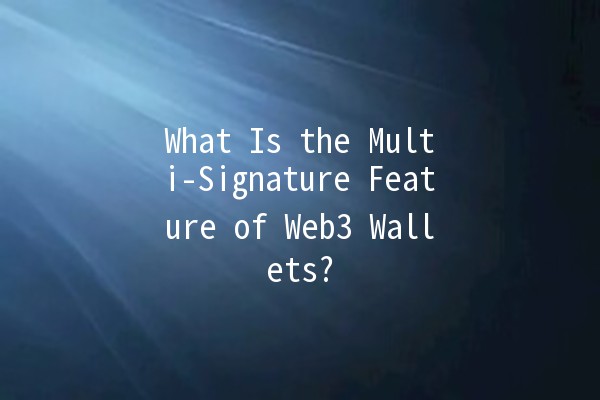
Web3 technology and decentralized finance (DeFi) have revolutionized the way we think about managing digital assets. As more users venture into the realm of cryptocurrencies, understanding new features in wallets becomes essential. One such feature is the multisignature (multisig) function, which enhances security and governance for digital wallets. In this article, we will explore what a multisig wallet is, how it works, and practical tips on using this feature effectively.
Understanding MultiSignature Wallets
A multisignature wallet is a digital wallet that requires multiple keys (signatures) to authorize a transaction. This means that rather than having a single private key that controls access to the wallet, multiple parties must sign off on any movements of assets.
How MultiSignature Works

To set up a multisignature wallet, users can define a certain number of required signatures for any transaction to proceed. For example, in a 2of3 multisig wallet, three private keys are created, but any two of those keys must sign a transaction before it is executed. By distributing control among different parties, the wallet enhances security and mitigates risks associated with losing a single key or unauthorized access.
Key Benefits of MultiSignature Wallets
Practical Tips for Using MultiSignature Wallets
When selecting a multisignature wallet, opt for a reputable provider with a solid track record. Look for wallets that support robust security features, userfriendly interfaces, and good customer support. Research user reviews and expert opinions to guide your choice.
Example Application
Suppose you're starting a new decentralized application (dApp) and require funds shared among several developers. A reputable wallet provider like Gnosis Safe can help you set up a secure multisig wallet with access controlled by all developers.
Before creating a multisig wallet, outline roles and responsibilities for each keyholder. Clearly define who has control over which keys and under what conditions they can use them.
Example Application
In a project with three founders, you might decide that one founder handles development keys, another manages marketing funds, and the third oversees operational expenses. This way, each founder knows when and how they can sign transactions.
As projects evolve or change, ensure that key holders are still relevant and necessary. Regularly review who has access and what rights they hold. If a keyholder leaves the project, make sure to create a new wallet or revoke their access.
Example Application
Imagine a startup where one of the partners decides to exit the business. Conduct a review immediately and either change the multisig setup or transfer the assets to a new wallet to maintain security.
Establish a standardized process for initiating, reviewing, and approving transactions. This process should include checks and guidelines to ensure that all parties understand how transactions will be managed.
Example Application
Suppose your multisig wallet manages community funds for a nonprofit organization. A defined process might involve submitting a transaction request that must be reviewed by all board members before signatures are collected.
Many multisig wallets have builtin alert systems to notify users of transaction requests or confirmations. Implement these alerts to stay updated on wallet activities and to quickly act if anything seems unauthorized.
Example Application
For a corporate treasury using a multisig wallet, setting up alerts for transaction requests will ensure that all authorized parties are notified immediately when a transaction is initiated, helping maintain transparency and accountability.
Answering Frequently Asked Questions (FAQs)
To create a multisignature wallet, users need to choose a wallet provider that supports multisignature functionality. The process typically involves generating the required number of keys and specifying how many signatures are necessary to approve a transaction. Users can then invite others to hold a key.
In a multisignature wallet, if one key is lost, the funds remain secure as long as the required number of signatures can still be obtained. For example, in a 2of3 setup, losing one key still allows access to funds using the remaining two keys. However, it’s advisable to establish a backup plan for lost keys to prevent access issues.
Yes, multisignature wallets can certainly be used for personal purposes. Individuals may set up a multisig wallet to require approval from trusted family members or friends before making significant transactions, adding an extra layer of security.
Absolutely! Multisignature wallets are particularly wellsuited for businesses as they require multiple approvals for spending, thereby reducing the risk of fraud or financial irresponsibility.
Transaction fees for multisignature wallets are generally similar to regular wallets, as they are primarily determined by the network's conditions (such as Ethereum gas fees). However, individuals should be aware that since multiple keys must sign off, it can take longer to execute transactions, potentially impacting fees.
Yes, many multisignature wallet providers offer support for multiple cryptocurrencies, allowing users to manage various digital assets in a single wallet. Be sure to check the supported coins when selecting a wallet provider.
, utilizing multisignature wallets can significantly enhance security in managing digital assets. By ensuring that multiple parties are involved in transaction approvals, users can better safeguard their funds against unauthorized access and human error. Implementing a multisig feature in your wallet strategy can lead to more responsible asset management and foster trust among stakeholders. Whether you're an individual, a startup, or a large corporation, adopting multisignature functionalities will help advance your journey in the decentralized world.

